Nuclear Energy: Technology, Status, and Prospects
VerifiedAdded on 2023/03/30
|15
|2625
|80
AI Summary
This report reviews the technology behind nuclear power, the current status and prospects of nuclear power. Nuclear energy is generated through the fission of radioactive materials in a nuclear reactor. The quantity of energy generated through nuclear reaction is larger than the electricity generated from other conventional sources.
Contribute Materials
Your contribution can guide someone’s learning journey. Share your
documents today.
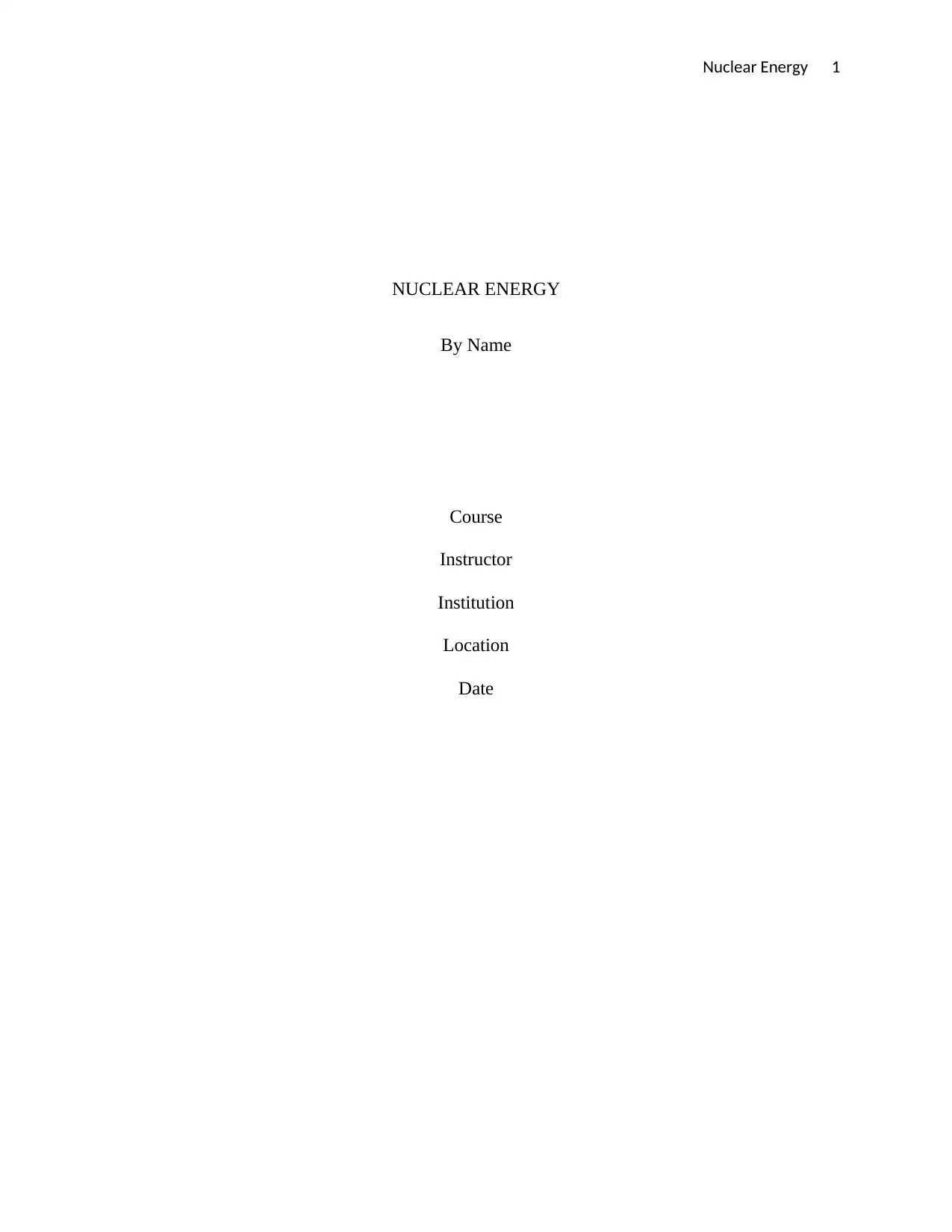
Nuclear Energy 1
NUCLEAR ENERGY
By Name
Course
Instructor
Institution
Location
Date
NUCLEAR ENERGY
By Name
Course
Instructor
Institution
Location
Date
Secure Best Marks with AI Grader
Need help grading? Try our AI Grader for instant feedback on your assignments.
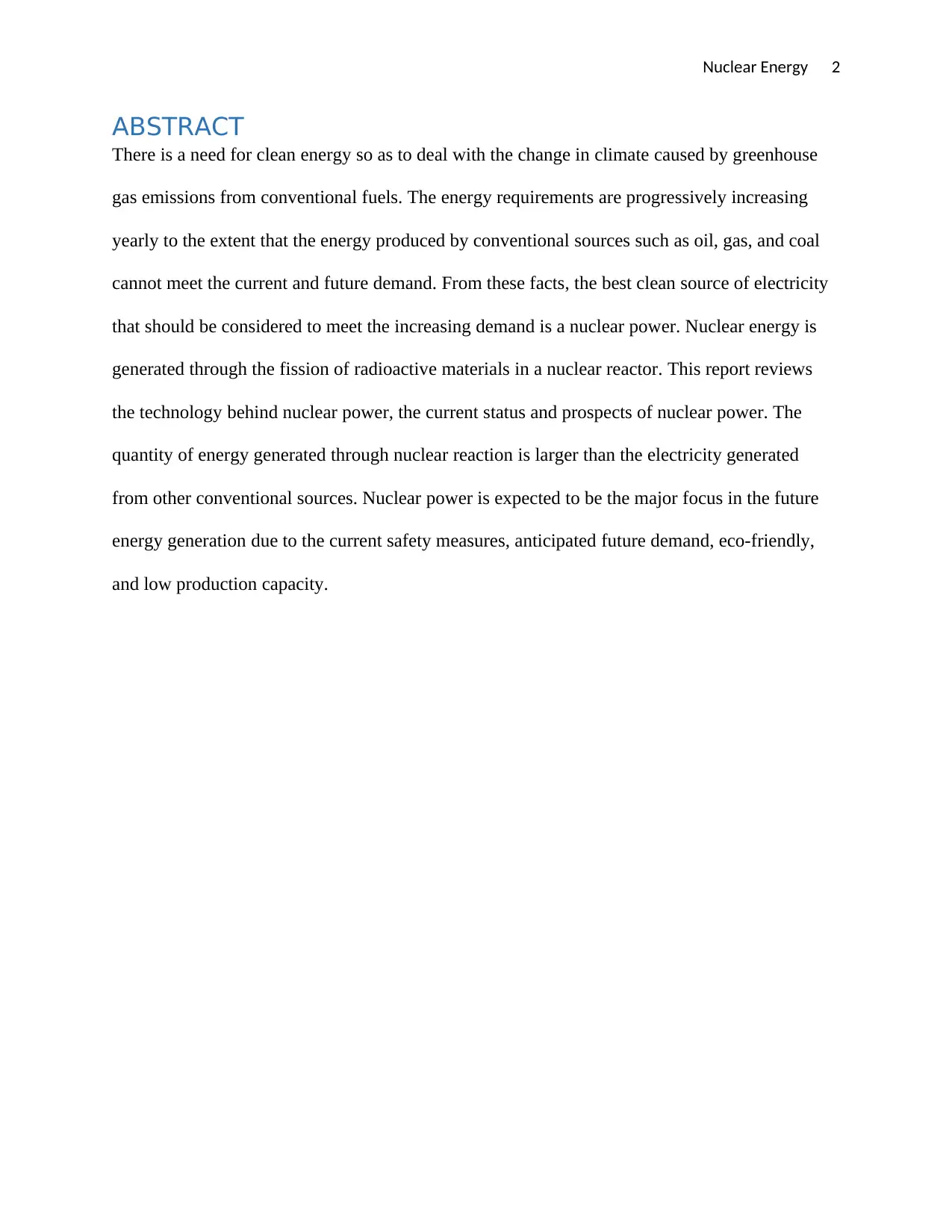
Nuclear Energy 2
ABSTRACT
There is a need for clean energy so as to deal with the change in climate caused by greenhouse
gas emissions from conventional fuels. The energy requirements are progressively increasing
yearly to the extent that the energy produced by conventional sources such as oil, gas, and coal
cannot meet the current and future demand. From these facts, the best clean source of electricity
that should be considered to meet the increasing demand is a nuclear power. Nuclear energy is
generated through the fission of radioactive materials in a nuclear reactor. This report reviews
the technology behind nuclear power, the current status and prospects of nuclear power. The
quantity of energy generated through nuclear reaction is larger than the electricity generated
from other conventional sources. Nuclear power is expected to be the major focus in the future
energy generation due to the current safety measures, anticipated future demand, eco-friendly,
and low production capacity.
ABSTRACT
There is a need for clean energy so as to deal with the change in climate caused by greenhouse
gas emissions from conventional fuels. The energy requirements are progressively increasing
yearly to the extent that the energy produced by conventional sources such as oil, gas, and coal
cannot meet the current and future demand. From these facts, the best clean source of electricity
that should be considered to meet the increasing demand is a nuclear power. Nuclear energy is
generated through the fission of radioactive materials in a nuclear reactor. This report reviews
the technology behind nuclear power, the current status and prospects of nuclear power. The
quantity of energy generated through nuclear reaction is larger than the electricity generated
from other conventional sources. Nuclear power is expected to be the major focus in the future
energy generation due to the current safety measures, anticipated future demand, eco-friendly,
and low production capacity.
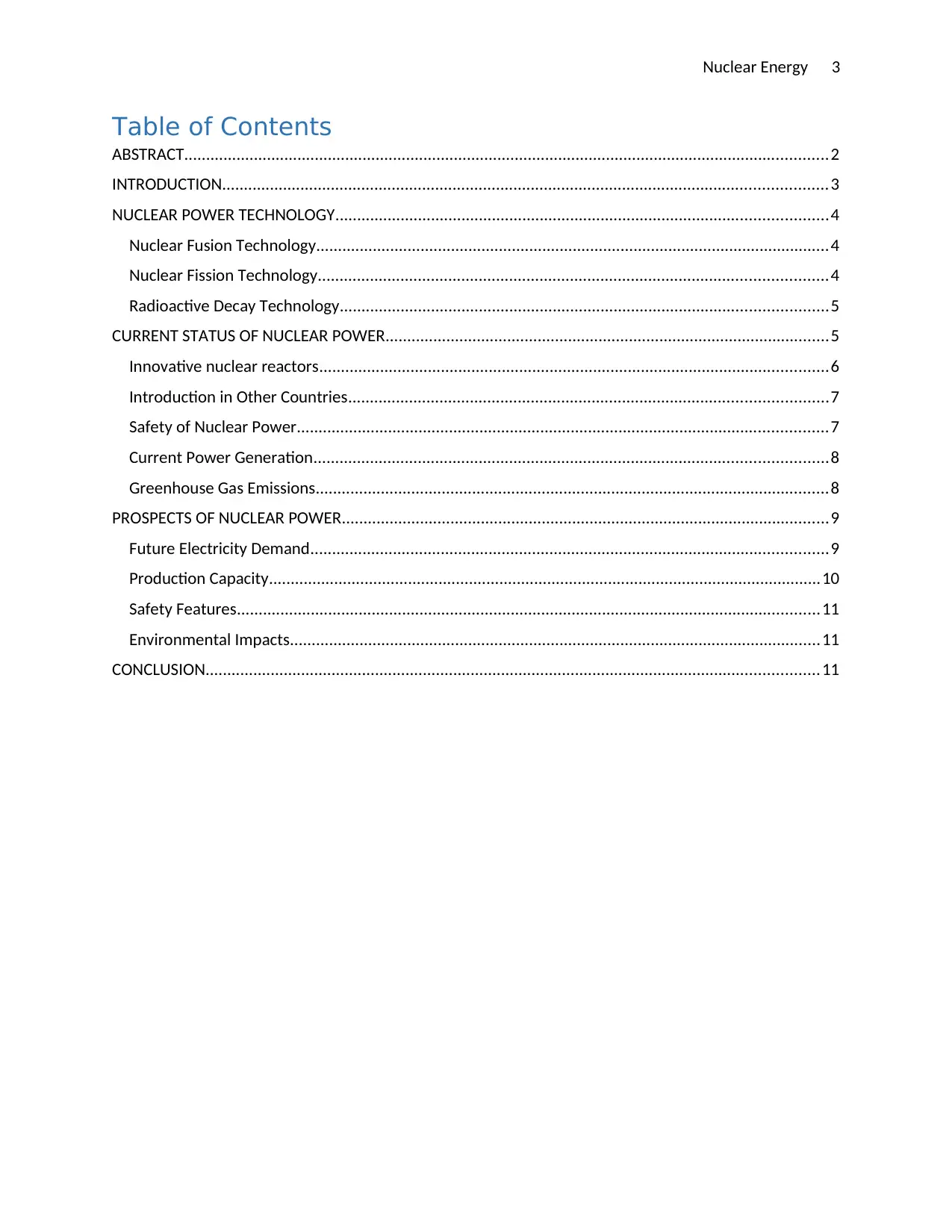
Nuclear Energy 3
Table of Contents
ABSTRACT....................................................................................................................................................2
INTRODUCTION...........................................................................................................................................3
NUCLEAR POWER TECHNOLOGY.................................................................................................................4
Nuclear Fusion Technology......................................................................................................................4
Nuclear Fission Technology.....................................................................................................................4
Radioactive Decay Technology................................................................................................................5
CURRENT STATUS OF NUCLEAR POWER......................................................................................................5
Innovative nuclear reactors.....................................................................................................................6
Introduction in Other Countries..............................................................................................................7
Safety of Nuclear Power..........................................................................................................................7
Current Power Generation......................................................................................................................8
Greenhouse Gas Emissions......................................................................................................................8
PROSPECTS OF NUCLEAR POWER................................................................................................................9
Future Electricity Demand.......................................................................................................................9
Production Capacity...............................................................................................................................10
Safety Features......................................................................................................................................11
Environmental Impacts..........................................................................................................................11
CONCLUSION.............................................................................................................................................11
Table of Contents
ABSTRACT....................................................................................................................................................2
INTRODUCTION...........................................................................................................................................3
NUCLEAR POWER TECHNOLOGY.................................................................................................................4
Nuclear Fusion Technology......................................................................................................................4
Nuclear Fission Technology.....................................................................................................................4
Radioactive Decay Technology................................................................................................................5
CURRENT STATUS OF NUCLEAR POWER......................................................................................................5
Innovative nuclear reactors.....................................................................................................................6
Introduction in Other Countries..............................................................................................................7
Safety of Nuclear Power..........................................................................................................................7
Current Power Generation......................................................................................................................8
Greenhouse Gas Emissions......................................................................................................................8
PROSPECTS OF NUCLEAR POWER................................................................................................................9
Future Electricity Demand.......................................................................................................................9
Production Capacity...............................................................................................................................10
Safety Features......................................................................................................................................11
Environmental Impacts..........................................................................................................................11
CONCLUSION.............................................................................................................................................11
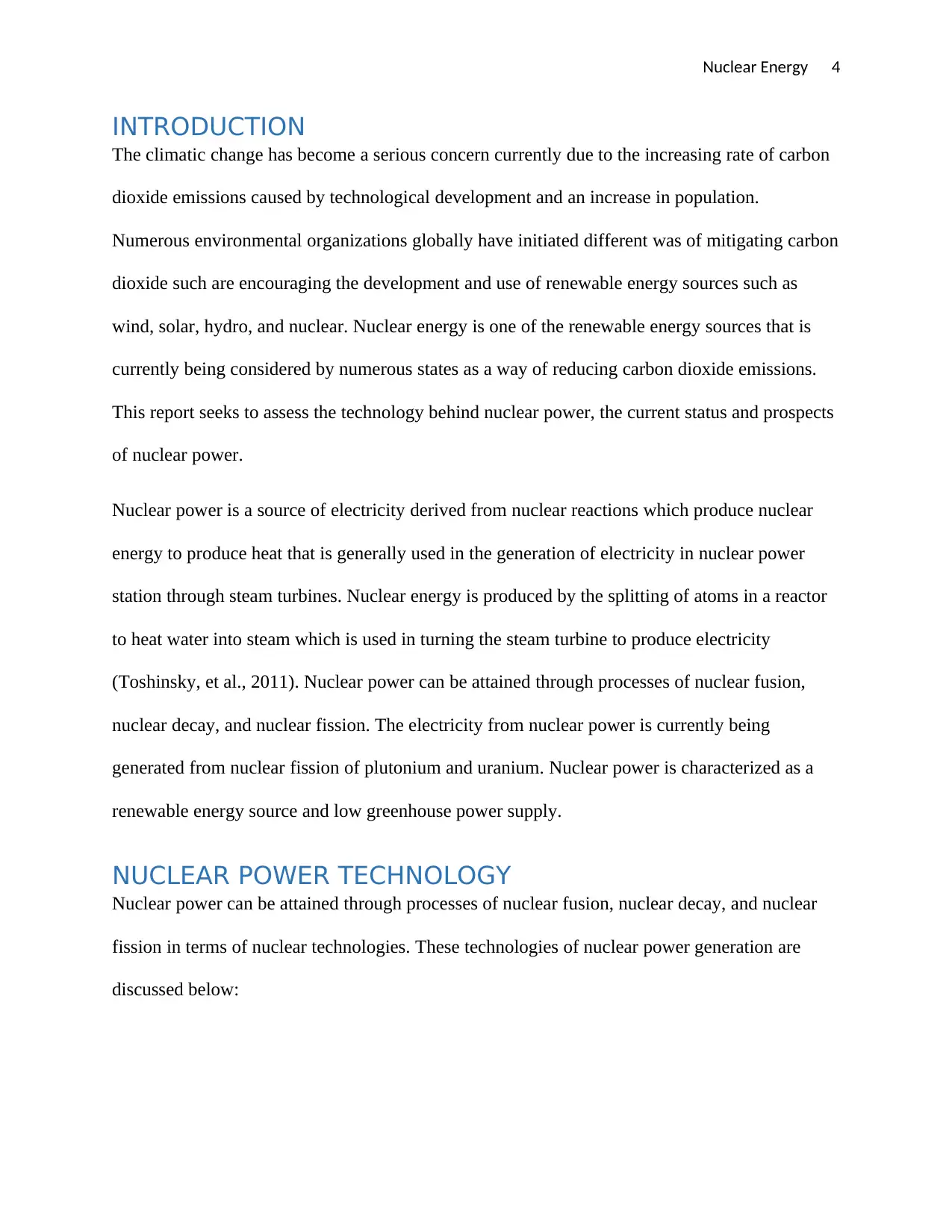
Nuclear Energy 4
INTRODUCTION
The climatic change has become a serious concern currently due to the increasing rate of carbon
dioxide emissions caused by technological development and an increase in population.
Numerous environmental organizations globally have initiated different was of mitigating carbon
dioxide such are encouraging the development and use of renewable energy sources such as
wind, solar, hydro, and nuclear. Nuclear energy is one of the renewable energy sources that is
currently being considered by numerous states as a way of reducing carbon dioxide emissions.
This report seeks to assess the technology behind nuclear power, the current status and prospects
of nuclear power.
Nuclear power is a source of electricity derived from nuclear reactions which produce nuclear
energy to produce heat that is generally used in the generation of electricity in nuclear power
station through steam turbines. Nuclear energy is produced by the splitting of atoms in a reactor
to heat water into steam which is used in turning the steam turbine to produce electricity
(Toshinsky, et al., 2011). Nuclear power can be attained through processes of nuclear fusion,
nuclear decay, and nuclear fission. The electricity from nuclear power is currently being
generated from nuclear fission of plutonium and uranium. Nuclear power is characterized as a
renewable energy source and low greenhouse power supply.
NUCLEAR POWER TECHNOLOGY
Nuclear power can be attained through processes of nuclear fusion, nuclear decay, and nuclear
fission in terms of nuclear technologies. These technologies of nuclear power generation are
discussed below:
INTRODUCTION
The climatic change has become a serious concern currently due to the increasing rate of carbon
dioxide emissions caused by technological development and an increase in population.
Numerous environmental organizations globally have initiated different was of mitigating carbon
dioxide such are encouraging the development and use of renewable energy sources such as
wind, solar, hydro, and nuclear. Nuclear energy is one of the renewable energy sources that is
currently being considered by numerous states as a way of reducing carbon dioxide emissions.
This report seeks to assess the technology behind nuclear power, the current status and prospects
of nuclear power.
Nuclear power is a source of electricity derived from nuclear reactions which produce nuclear
energy to produce heat that is generally used in the generation of electricity in nuclear power
station through steam turbines. Nuclear energy is produced by the splitting of atoms in a reactor
to heat water into steam which is used in turning the steam turbine to produce electricity
(Toshinsky, et al., 2011). Nuclear power can be attained through processes of nuclear fusion,
nuclear decay, and nuclear fission. The electricity from nuclear power is currently being
generated from nuclear fission of plutonium and uranium. Nuclear power is characterized as a
renewable energy source and low greenhouse power supply.
NUCLEAR POWER TECHNOLOGY
Nuclear power can be attained through processes of nuclear fusion, nuclear decay, and nuclear
fission in terms of nuclear technologies. These technologies of nuclear power generation are
discussed below:
Secure Best Marks with AI Grader
Need help grading? Try our AI Grader for instant feedback on your assignments.
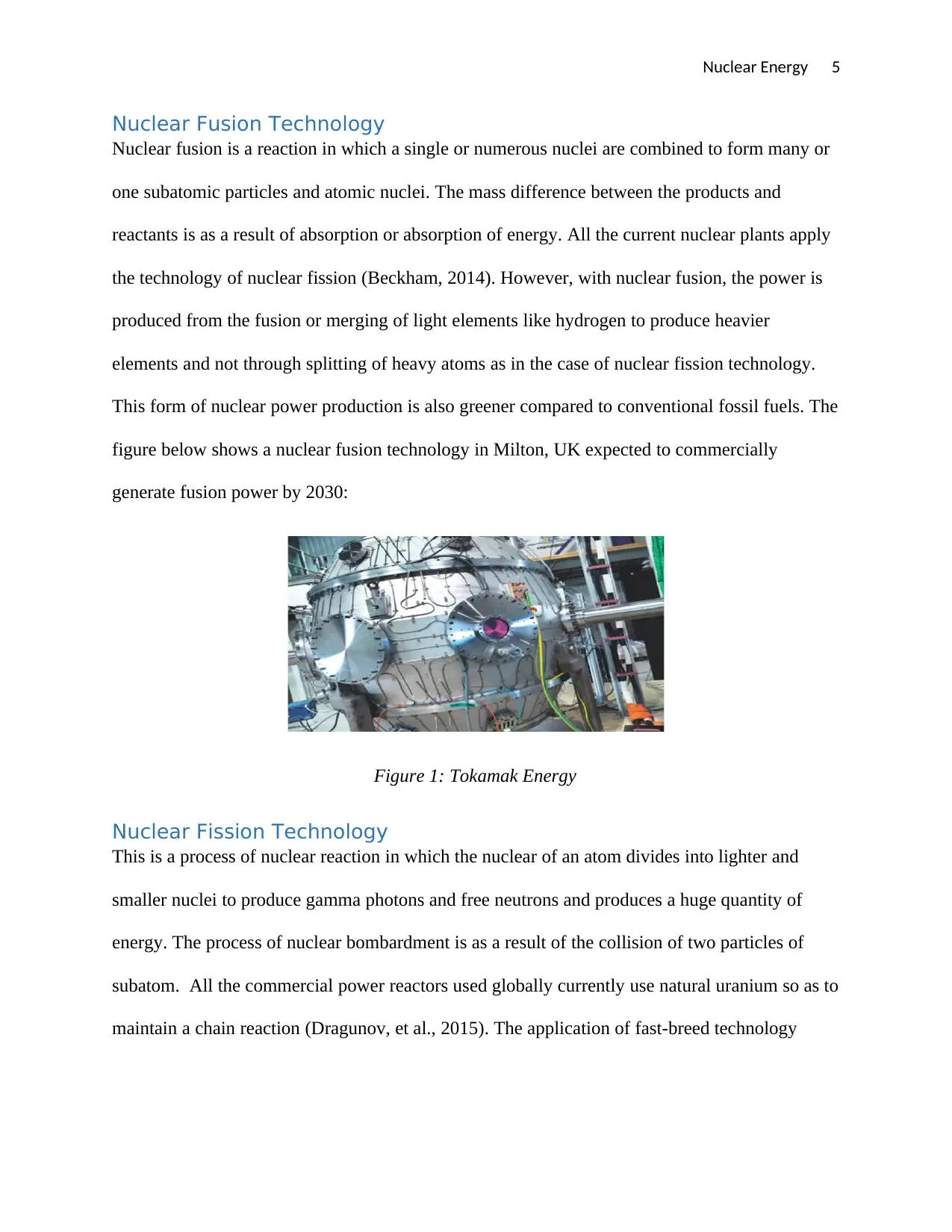
Nuclear Energy 5
Nuclear Fusion Technology
Nuclear fusion is a reaction in which a single or numerous nuclei are combined to form many or
one subatomic particles and atomic nuclei. The mass difference between the products and
reactants is as a result of absorption or absorption of energy. All the current nuclear plants apply
the technology of nuclear fission (Beckham, 2014). However, with nuclear fusion, the power is
produced from the fusion or merging of light elements like hydrogen to produce heavier
elements and not through splitting of heavy atoms as in the case of nuclear fission technology.
This form of nuclear power production is also greener compared to conventional fossil fuels. The
figure below shows a nuclear fusion technology in Milton, UK expected to commercially
generate fusion power by 2030:
Figure 1: Tokamak Energy
Nuclear Fission Technology
This is a process of nuclear reaction in which the nuclear of an atom divides into lighter and
smaller nuclei to produce gamma photons and free neutrons and produces a huge quantity of
energy. The process of nuclear bombardment is as a result of the collision of two particles of
subatom. All the commercial power reactors used globally currently use natural uranium so as to
maintain a chain reaction (Dragunov, et al., 2015). The application of fast-breed technology
Nuclear Fusion Technology
Nuclear fusion is a reaction in which a single or numerous nuclei are combined to form many or
one subatomic particles and atomic nuclei. The mass difference between the products and
reactants is as a result of absorption or absorption of energy. All the current nuclear plants apply
the technology of nuclear fission (Beckham, 2014). However, with nuclear fusion, the power is
produced from the fusion or merging of light elements like hydrogen to produce heavier
elements and not through splitting of heavy atoms as in the case of nuclear fission technology.
This form of nuclear power production is also greener compared to conventional fossil fuels. The
figure below shows a nuclear fusion technology in Milton, UK expected to commercially
generate fusion power by 2030:
Figure 1: Tokamak Energy
Nuclear Fission Technology
This is a process of nuclear reaction in which the nuclear of an atom divides into lighter and
smaller nuclei to produce gamma photons and free neutrons and produces a huge quantity of
energy. The process of nuclear bombardment is as a result of the collision of two particles of
subatom. All the commercial power reactors used globally currently use natural uranium so as to
maintain a chain reaction (Dragunov, et al., 2015). The application of fast-breed technology
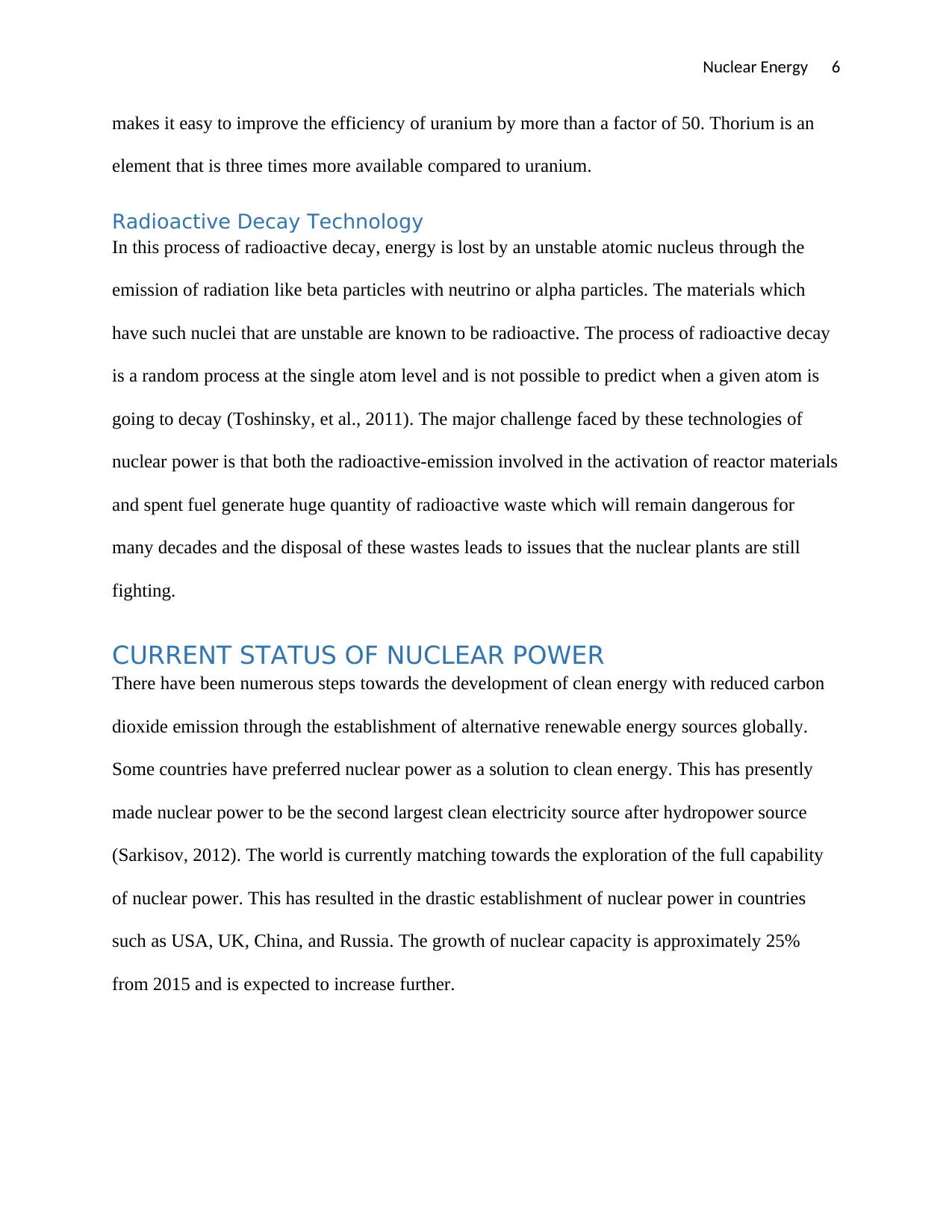
Nuclear Energy 6
makes it easy to improve the efficiency of uranium by more than a factor of 50. Thorium is an
element that is three times more available compared to uranium.
Radioactive Decay Technology
In this process of radioactive decay, energy is lost by an unstable atomic nucleus through the
emission of radiation like beta particles with neutrino or alpha particles. The materials which
have such nuclei that are unstable are known to be radioactive. The process of radioactive decay
is a random process at the single atom level and is not possible to predict when a given atom is
going to decay (Toshinsky, et al., 2011). The major challenge faced by these technologies of
nuclear power is that both the radioactive-emission involved in the activation of reactor materials
and spent fuel generate huge quantity of radioactive waste which will remain dangerous for
many decades and the disposal of these wastes leads to issues that the nuclear plants are still
fighting.
CURRENT STATUS OF NUCLEAR POWER
There have been numerous steps towards the development of clean energy with reduced carbon
dioxide emission through the establishment of alternative renewable energy sources globally.
Some countries have preferred nuclear power as a solution to clean energy. This has presently
made nuclear power to be the second largest clean electricity source after hydropower source
(Sarkisov, 2012). The world is currently matching towards the exploration of the full capability
of nuclear power. This has resulted in the drastic establishment of nuclear power in countries
such as USA, UK, China, and Russia. The growth of nuclear capacity is approximately 25%
from 2015 and is expected to increase further.
makes it easy to improve the efficiency of uranium by more than a factor of 50. Thorium is an
element that is three times more available compared to uranium.
Radioactive Decay Technology
In this process of radioactive decay, energy is lost by an unstable atomic nucleus through the
emission of radiation like beta particles with neutrino or alpha particles. The materials which
have such nuclei that are unstable are known to be radioactive. The process of radioactive decay
is a random process at the single atom level and is not possible to predict when a given atom is
going to decay (Toshinsky, et al., 2011). The major challenge faced by these technologies of
nuclear power is that both the radioactive-emission involved in the activation of reactor materials
and spent fuel generate huge quantity of radioactive waste which will remain dangerous for
many decades and the disposal of these wastes leads to issues that the nuclear plants are still
fighting.
CURRENT STATUS OF NUCLEAR POWER
There have been numerous steps towards the development of clean energy with reduced carbon
dioxide emission through the establishment of alternative renewable energy sources globally.
Some countries have preferred nuclear power as a solution to clean energy. This has presently
made nuclear power to be the second largest clean electricity source after hydropower source
(Sarkisov, 2012). The world is currently matching towards the exploration of the full capability
of nuclear power. This has resulted in the drastic establishment of nuclear power in countries
such as USA, UK, China, and Russia. The growth of nuclear capacity is approximately 25%
from 2015 and is expected to increase further.
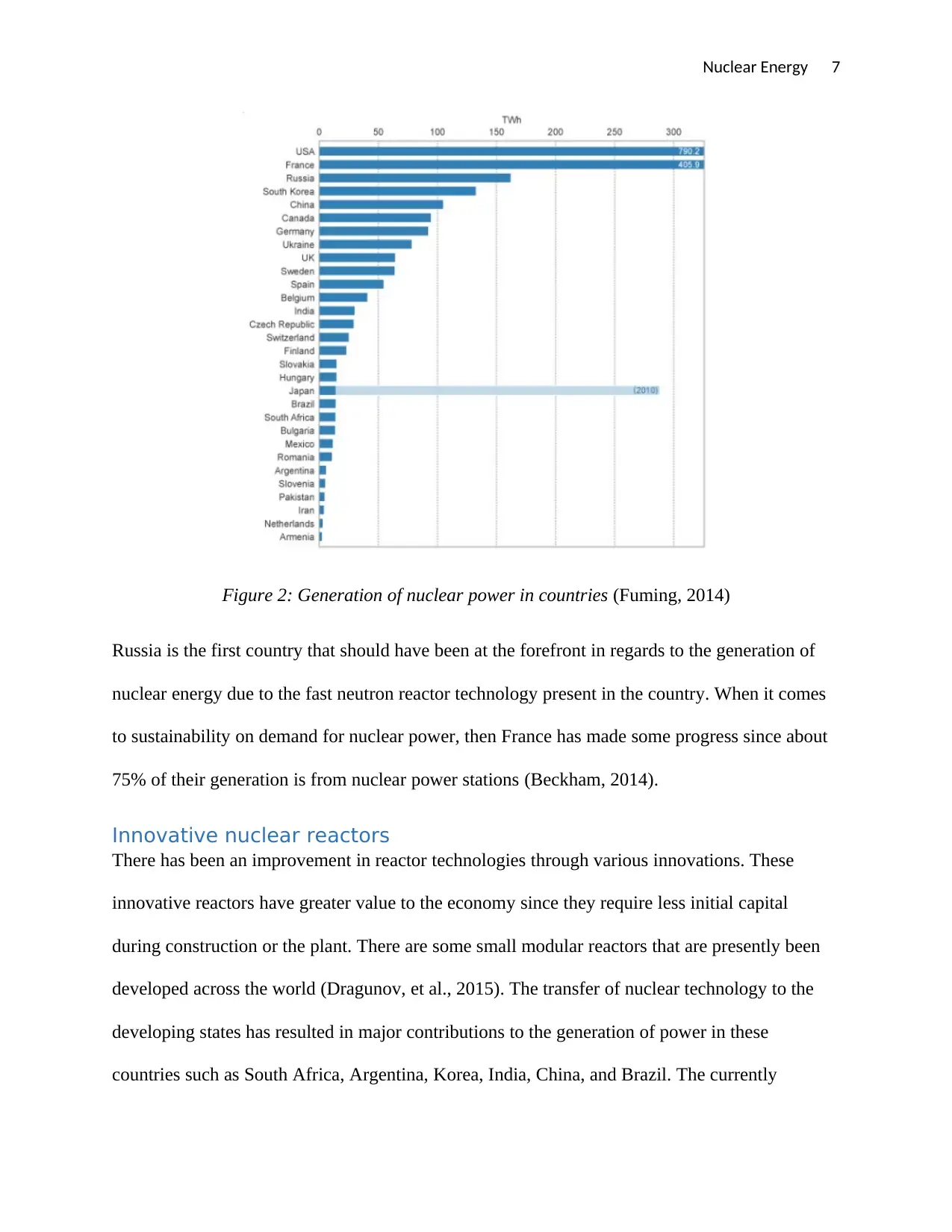
Nuclear Energy 7
Figure 2: Generation of nuclear power in countries (Fuming, 2014)
Russia is the first country that should have been at the forefront in regards to the generation of
nuclear energy due to the fast neutron reactor technology present in the country. When it comes
to sustainability on demand for nuclear power, then France has made some progress since about
75% of their generation is from nuclear power stations (Beckham, 2014).
Innovative nuclear reactors
There has been an improvement in reactor technologies through various innovations. These
innovative reactors have greater value to the economy since they require less initial capital
during construction or the plant. There are some small modular reactors that are presently been
developed across the world (Dragunov, et al., 2015). The transfer of nuclear technology to the
developing states has resulted in major contributions to the generation of power in these
countries such as South Africa, Argentina, Korea, India, China, and Brazil. The currently
Figure 2: Generation of nuclear power in countries (Fuming, 2014)
Russia is the first country that should have been at the forefront in regards to the generation of
nuclear energy due to the fast neutron reactor technology present in the country. When it comes
to sustainability on demand for nuclear power, then France has made some progress since about
75% of their generation is from nuclear power stations (Beckham, 2014).
Innovative nuclear reactors
There has been an improvement in reactor technologies through various innovations. These
innovative reactors have greater value to the economy since they require less initial capital
during construction or the plant. There are some small modular reactors that are presently been
developed across the world (Dragunov, et al., 2015). The transfer of nuclear technology to the
developing states has resulted in major contributions to the generation of power in these
countries such as South Africa, Argentina, Korea, India, China, and Brazil. The currently
Paraphrase This Document
Need a fresh take? Get an instant paraphrase of this document with our AI Paraphraser
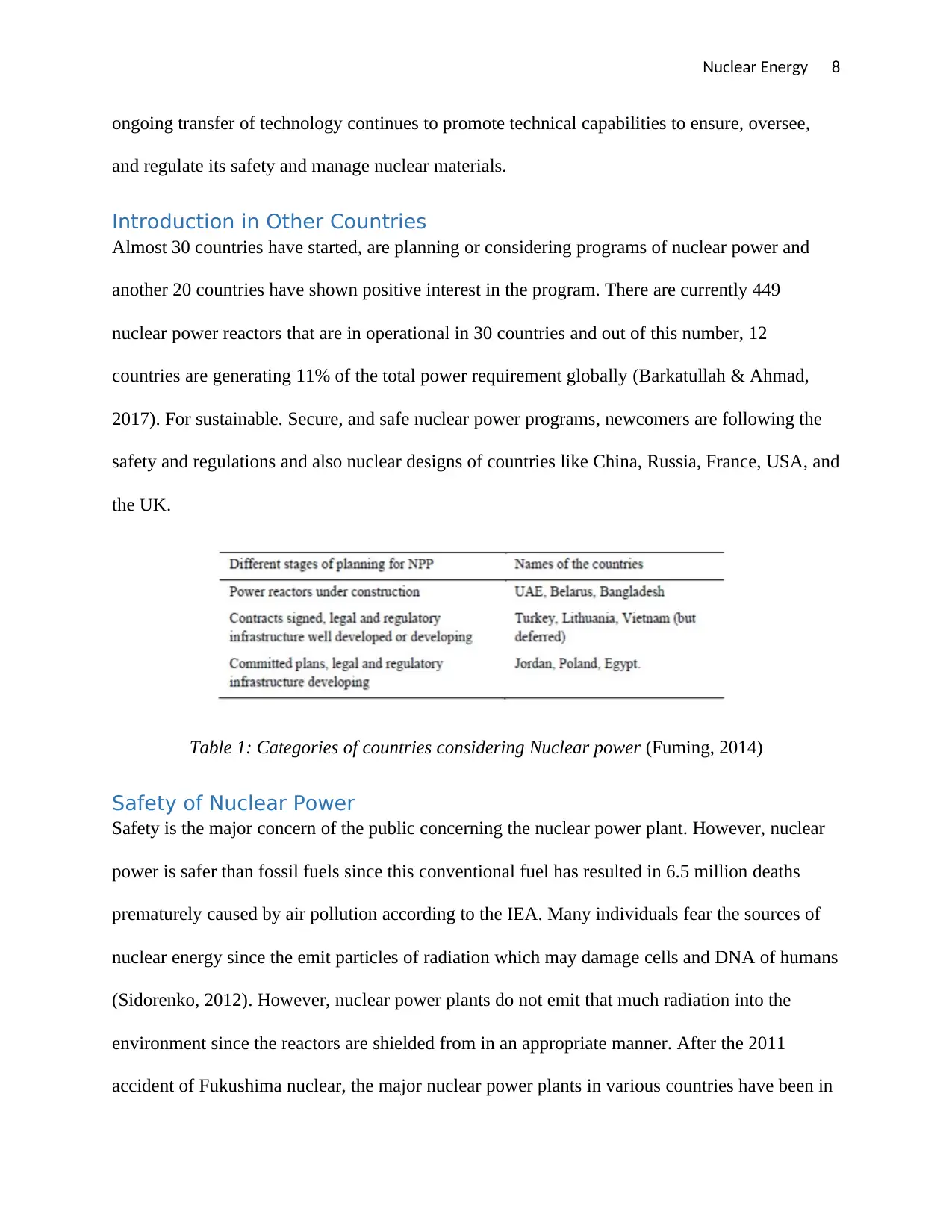
Nuclear Energy 8
ongoing transfer of technology continues to promote technical capabilities to ensure, oversee,
and regulate its safety and manage nuclear materials.
Introduction in Other Countries
Almost 30 countries have started, are planning or considering programs of nuclear power and
another 20 countries have shown positive interest in the program. There are currently 449
nuclear power reactors that are in operational in 30 countries and out of this number, 12
countries are generating 11% of the total power requirement globally (Barkatullah & Ahmad,
2017). For sustainable. Secure, and safe nuclear power programs, newcomers are following the
safety and regulations and also nuclear designs of countries like China, Russia, France, USA, and
the UK.
Table 1: Categories of countries considering Nuclear power (Fuming, 2014)
Safety of Nuclear Power
Safety is the major concern of the public concerning the nuclear power plant. However, nuclear
power is safer than fossil fuels since this conventional fuel has resulted in 6.5 million deaths
prematurely caused by air pollution according to the IEA. Many individuals fear the sources of
nuclear energy since the emit particles of radiation which may damage cells and DNA of humans
(Sidorenko, 2012). However, nuclear power plants do not emit that much radiation into the
environment since the reactors are shielded from in an appropriate manner. After the 2011
accident of Fukushima nuclear, the major nuclear power plants in various countries have been in
ongoing transfer of technology continues to promote technical capabilities to ensure, oversee,
and regulate its safety and manage nuclear materials.
Introduction in Other Countries
Almost 30 countries have started, are planning or considering programs of nuclear power and
another 20 countries have shown positive interest in the program. There are currently 449
nuclear power reactors that are in operational in 30 countries and out of this number, 12
countries are generating 11% of the total power requirement globally (Barkatullah & Ahmad,
2017). For sustainable. Secure, and safe nuclear power programs, newcomers are following the
safety and regulations and also nuclear designs of countries like China, Russia, France, USA, and
the UK.
Table 1: Categories of countries considering Nuclear power (Fuming, 2014)
Safety of Nuclear Power
Safety is the major concern of the public concerning the nuclear power plant. However, nuclear
power is safer than fossil fuels since this conventional fuel has resulted in 6.5 million deaths
prematurely caused by air pollution according to the IEA. Many individuals fear the sources of
nuclear energy since the emit particles of radiation which may damage cells and DNA of humans
(Sidorenko, 2012). However, nuclear power plants do not emit that much radiation into the
environment since the reactors are shielded from in an appropriate manner. After the 2011
accident of Fukushima nuclear, the major nuclear power plants in various countries have been in
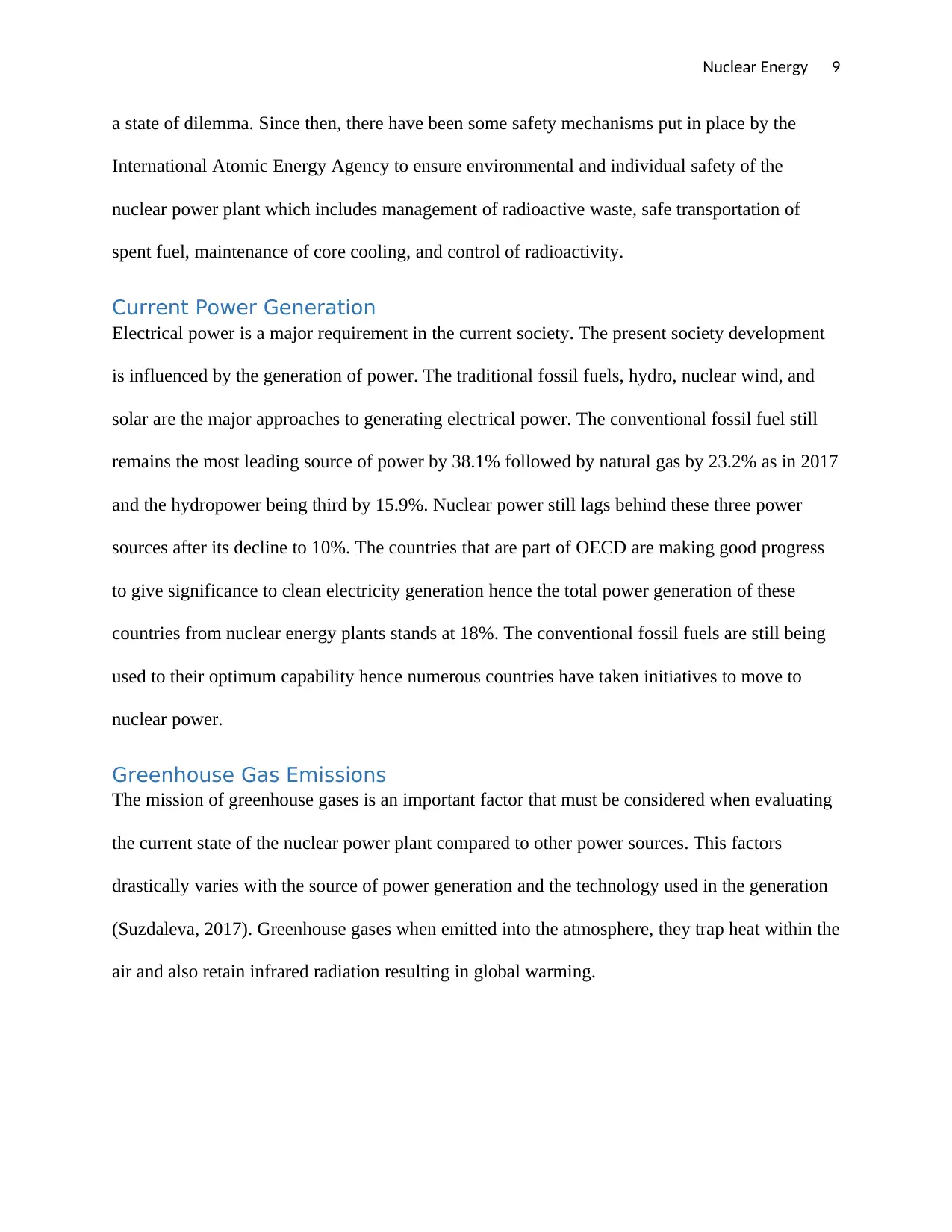
Nuclear Energy 9
a state of dilemma. Since then, there have been some safety mechanisms put in place by the
International Atomic Energy Agency to ensure environmental and individual safety of the
nuclear power plant which includes management of radioactive waste, safe transportation of
spent fuel, maintenance of core cooling, and control of radioactivity.
Current Power Generation
Electrical power is a major requirement in the current society. The present society development
is influenced by the generation of power. The traditional fossil fuels, hydro, nuclear wind, and
solar are the major approaches to generating electrical power. The conventional fossil fuel still
remains the most leading source of power by 38.1% followed by natural gas by 23.2% as in 2017
and the hydropower being third by 15.9%. Nuclear power still lags behind these three power
sources after its decline to 10%. The countries that are part of OECD are making good progress
to give significance to clean electricity generation hence the total power generation of these
countries from nuclear energy plants stands at 18%. The conventional fossil fuels are still being
used to their optimum capability hence numerous countries have taken initiatives to move to
nuclear power.
Greenhouse Gas Emissions
The mission of greenhouse gases is an important factor that must be considered when evaluating
the current state of the nuclear power plant compared to other power sources. This factors
drastically varies with the source of power generation and the technology used in the generation
(Suzdaleva, 2017). Greenhouse gases when emitted into the atmosphere, they trap heat within the
air and also retain infrared radiation resulting in global warming.
a state of dilemma. Since then, there have been some safety mechanisms put in place by the
International Atomic Energy Agency to ensure environmental and individual safety of the
nuclear power plant which includes management of radioactive waste, safe transportation of
spent fuel, maintenance of core cooling, and control of radioactivity.
Current Power Generation
Electrical power is a major requirement in the current society. The present society development
is influenced by the generation of power. The traditional fossil fuels, hydro, nuclear wind, and
solar are the major approaches to generating electrical power. The conventional fossil fuel still
remains the most leading source of power by 38.1% followed by natural gas by 23.2% as in 2017
and the hydropower being third by 15.9%. Nuclear power still lags behind these three power
sources after its decline to 10%. The countries that are part of OECD are making good progress
to give significance to clean electricity generation hence the total power generation of these
countries from nuclear energy plants stands at 18%. The conventional fossil fuels are still being
used to their optimum capability hence numerous countries have taken initiatives to move to
nuclear power.
Greenhouse Gas Emissions
The mission of greenhouse gases is an important factor that must be considered when evaluating
the current state of the nuclear power plant compared to other power sources. This factors
drastically varies with the source of power generation and the technology used in the generation
(Suzdaleva, 2017). Greenhouse gases when emitted into the atmosphere, they trap heat within the
air and also retain infrared radiation resulting in global warming.

Nuclear Energy 10
Figure 3: Emission of greenhouse gas in different plants (Ashrafi, et al., 2013)
Numerous research has been done to prove the nuclear power plant efficiency over other plants.
The result shows that the nuclear plants are one of the best options for low emission of
greenhouse gas compared to conventional fossil fuels. This is because nuclear plants are more
eco-friendly, avoid global warming, and preserve the integrity of the environment (Ashrafi, et al.,
2013).
PROSPECTS OF NUCLEAR POWER
Nuclear power has faced various controversies due to the concern about how the spread of
nuclear power may promote risks of nuclear weapons proliferation, storage of spent fuel, and
nuclear accidents.
Future Electricity Demand
There is a need for making proper speculation of the level at which electricity demand is
increasing globally so as to make a suitable generation plan. According to numerous research
done on the future demand of electricity, the current power supply will not be sufficient to meet
this increasing demand caused by increase in population, increase in the number of electrical
Figure 3: Emission of greenhouse gas in different plants (Ashrafi, et al., 2013)
Numerous research has been done to prove the nuclear power plant efficiency over other plants.
The result shows that the nuclear plants are one of the best options for low emission of
greenhouse gas compared to conventional fossil fuels. This is because nuclear plants are more
eco-friendly, avoid global warming, and preserve the integrity of the environment (Ashrafi, et al.,
2013).
PROSPECTS OF NUCLEAR POWER
Nuclear power has faced various controversies due to the concern about how the spread of
nuclear power may promote risks of nuclear weapons proliferation, storage of spent fuel, and
nuclear accidents.
Future Electricity Demand
There is a need for making proper speculation of the level at which electricity demand is
increasing globally so as to make a suitable generation plan. According to numerous research
done on the future demand of electricity, the current power supply will not be sufficient to meet
this increasing demand caused by increase in population, increase in the number of electrical
Secure Best Marks with AI Grader
Need help grading? Try our AI Grader for instant feedback on your assignments.
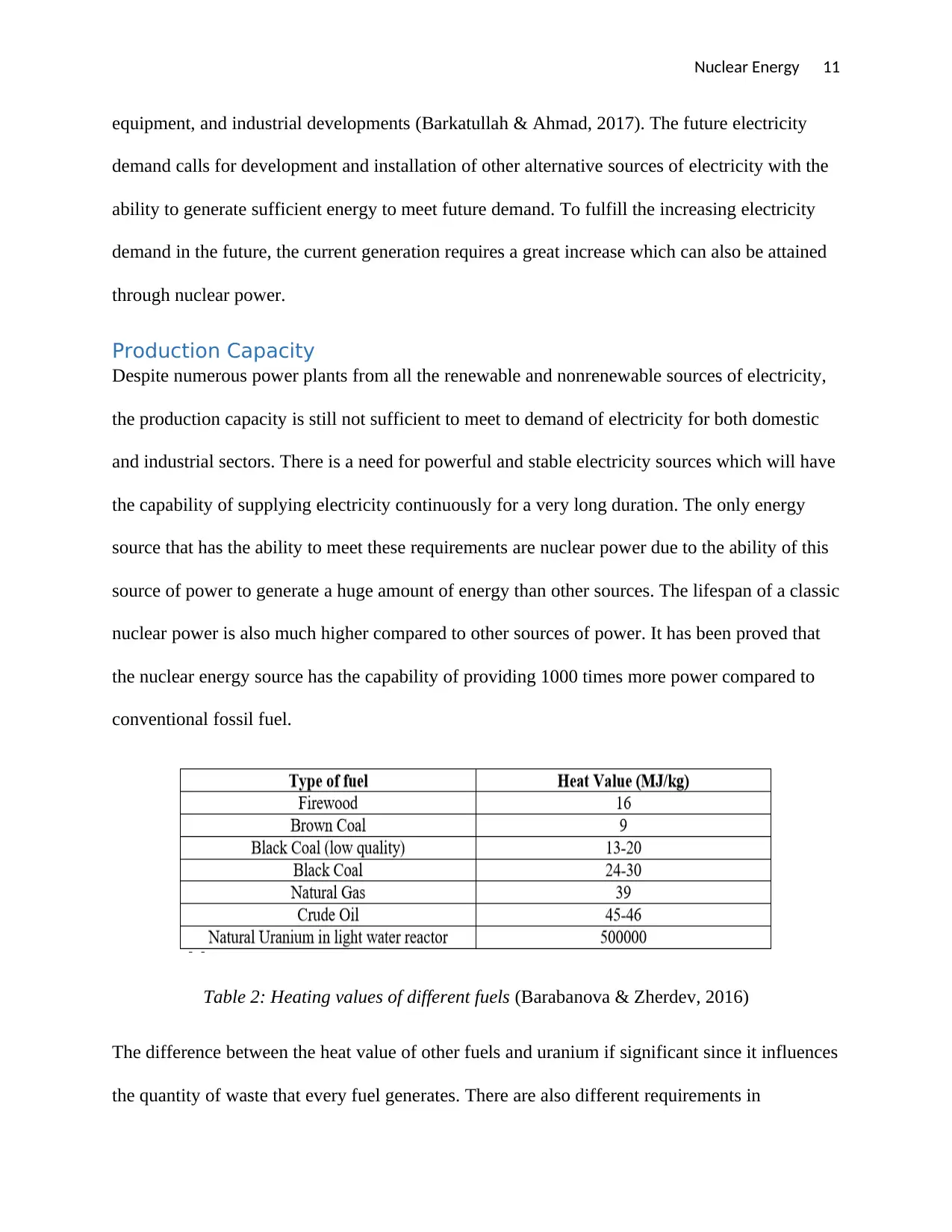
Nuclear Energy 11
equipment, and industrial developments (Barkatullah & Ahmad, 2017). The future electricity
demand calls for development and installation of other alternative sources of electricity with the
ability to generate sufficient energy to meet future demand. To fulfill the increasing electricity
demand in the future, the current generation requires a great increase which can also be attained
through nuclear power.
Production Capacity
Despite numerous power plants from all the renewable and nonrenewable sources of electricity,
the production capacity is still not sufficient to meet to demand of electricity for both domestic
and industrial sectors. There is a need for powerful and stable electricity sources which will have
the capability of supplying electricity continuously for a very long duration. The only energy
source that has the ability to meet these requirements are nuclear power due to the ability of this
source of power to generate a huge amount of energy than other sources. The lifespan of a classic
nuclear power is also much higher compared to other sources of power. It has been proved that
the nuclear energy source has the capability of providing 1000 times more power compared to
conventional fossil fuel.
Table 2: Heating values of different fuels (Barabanova & Zherdev, 2016)
The difference between the heat value of other fuels and uranium if significant since it influences
the quantity of waste that every fuel generates. There are also different requirements in
equipment, and industrial developments (Barkatullah & Ahmad, 2017). The future electricity
demand calls for development and installation of other alternative sources of electricity with the
ability to generate sufficient energy to meet future demand. To fulfill the increasing electricity
demand in the future, the current generation requires a great increase which can also be attained
through nuclear power.
Production Capacity
Despite numerous power plants from all the renewable and nonrenewable sources of electricity,
the production capacity is still not sufficient to meet to demand of electricity for both domestic
and industrial sectors. There is a need for powerful and stable electricity sources which will have
the capability of supplying electricity continuously for a very long duration. The only energy
source that has the ability to meet these requirements are nuclear power due to the ability of this
source of power to generate a huge amount of energy than other sources. The lifespan of a classic
nuclear power is also much higher compared to other sources of power. It has been proved that
the nuclear energy source has the capability of providing 1000 times more power compared to
conventional fossil fuel.
Table 2: Heating values of different fuels (Barabanova & Zherdev, 2016)
The difference between the heat value of other fuels and uranium if significant since it influences
the quantity of waste that every fuel generates. There are also different requirements in
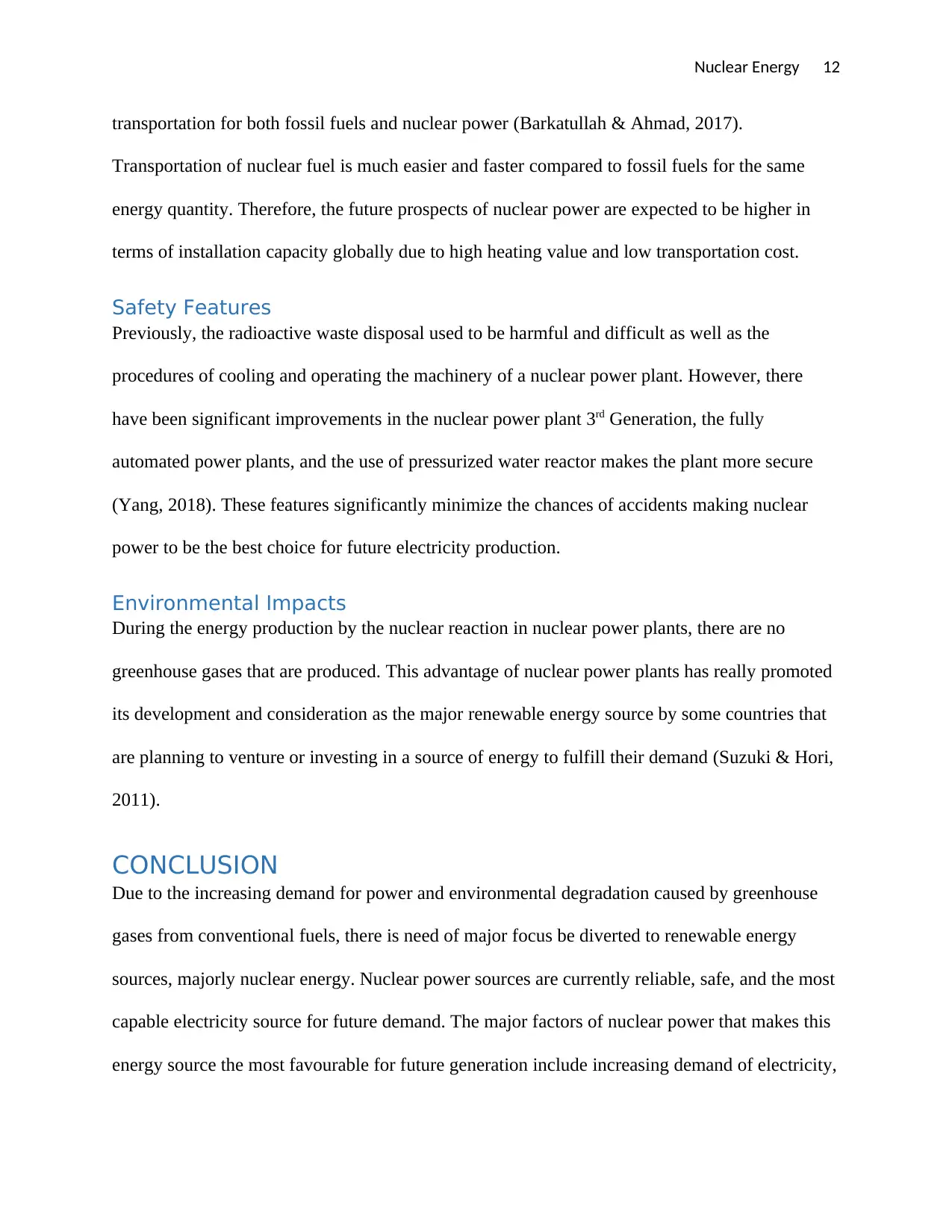
Nuclear Energy 12
transportation for both fossil fuels and nuclear power (Barkatullah & Ahmad, 2017).
Transportation of nuclear fuel is much easier and faster compared to fossil fuels for the same
energy quantity. Therefore, the future prospects of nuclear power are expected to be higher in
terms of installation capacity globally due to high heating value and low transportation cost.
Safety Features
Previously, the radioactive waste disposal used to be harmful and difficult as well as the
procedures of cooling and operating the machinery of a nuclear power plant. However, there
have been significant improvements in the nuclear power plant 3rd Generation, the fully
automated power plants, and the use of pressurized water reactor makes the plant more secure
(Yang, 2018). These features significantly minimize the chances of accidents making nuclear
power to be the best choice for future electricity production.
Environmental Impacts
During the energy production by the nuclear reaction in nuclear power plants, there are no
greenhouse gases that are produced. This advantage of nuclear power plants has really promoted
its development and consideration as the major renewable energy source by some countries that
are planning to venture or investing in a source of energy to fulfill their demand (Suzuki & Hori,
2011).
CONCLUSION
Due to the increasing demand for power and environmental degradation caused by greenhouse
gases from conventional fuels, there is need of major focus be diverted to renewable energy
sources, majorly nuclear energy. Nuclear power sources are currently reliable, safe, and the most
capable electricity source for future demand. The major factors of nuclear power that makes this
energy source the most favourable for future generation include increasing demand of electricity,
transportation for both fossil fuels and nuclear power (Barkatullah & Ahmad, 2017).
Transportation of nuclear fuel is much easier and faster compared to fossil fuels for the same
energy quantity. Therefore, the future prospects of nuclear power are expected to be higher in
terms of installation capacity globally due to high heating value and low transportation cost.
Safety Features
Previously, the radioactive waste disposal used to be harmful and difficult as well as the
procedures of cooling and operating the machinery of a nuclear power plant. However, there
have been significant improvements in the nuclear power plant 3rd Generation, the fully
automated power plants, and the use of pressurized water reactor makes the plant more secure
(Yang, 2018). These features significantly minimize the chances of accidents making nuclear
power to be the best choice for future electricity production.
Environmental Impacts
During the energy production by the nuclear reaction in nuclear power plants, there are no
greenhouse gases that are produced. This advantage of nuclear power plants has really promoted
its development and consideration as the major renewable energy source by some countries that
are planning to venture or investing in a source of energy to fulfill their demand (Suzuki & Hori,
2011).
CONCLUSION
Due to the increasing demand for power and environmental degradation caused by greenhouse
gases from conventional fuels, there is need of major focus be diverted to renewable energy
sources, majorly nuclear energy. Nuclear power sources are currently reliable, safe, and the most
capable electricity source for future demand. The major factors of nuclear power that makes this
energy source the most favourable for future generation include increasing demand of electricity,

Nuclear Energy 13
the expected high energy demand in future, environmentally friendly energy source, renewable
source of energy, an safety measures available.
the expected high energy demand in future, environmentally friendly energy source, renewable
source of energy, an safety measures available.
Paraphrase This Document
Need a fresh take? Get an instant paraphrase of this document with our AI Paraphraser

Nuclear Energy 14
BIBLIOGRAPHY
Ashrafi, O., Yerushalmi, L. & Haghighat, F., 2013. Greenhouse gas emission by wastewater treatment
plants of the pulp and paper industry – Modeling and simulation. International Journal of Greenhouse
Gas Control, Volume 17, pp. 462-472.
Barabanova, D. & Zherdev, G., 2016. Radioactive decay data uncertainties library of isotopes for ABBN
constant system. Nuclear Energy and Technology, Volume 2, pp. 1-4.
Barkatullah, N. & Ahmad, A., 2017. Current status and emerging trends in financing nuclear power
projects. Energy Strategy Reviews, Volume 18, pp. 127-140.
Beckham, C., 2014. Nuclear power in India: a book review. Journal of Cleaner Production, Volume 79, pp.
283-285.
Dragunov, A., Saltanov, E. & Kirillov, P., 2015. Power Cycles of Generation III and III+ Nuclear Power
Plants. Journal of Nuclear Engineering and Radiation Science, Volume 1, p. 210.
Fuming, J., 2014. Different Countries, Similar Nuclear Safety Culture: A Study on Comparison of Nuclear
Safety Cultures in China and USA. Journal of Nuclear Energy Science & Power Generation Technology,
Volume 3.
Sarkisov, A., 2012. A new direction for development – low-capacity nuclear power. Atomic Energy,
Volume 111, pp. 309-311.
Sidorenko, V., 2012. Tasks, problems, and possibilities of developing low-capacity nuclear power. Atomic
Energy, Volume 111, pp. 312-315.
Suzdaleva, A., 2017. Improving the general and ecological image of nuclear power. Nuclear Energy and
Technology, Volume 3, pp. 164-167.
Suzuki, A. & Hori, S., 2011. Current status of radiological protection at nuclear power stations in Japan.
Radiation Protection Dosimetry, Volume 146, pp. 343-346.
Toshinsky, G., Komlev, O. & Mel’nikov, K., 2011. Nuclear power technologies at the stage of sustainable
nuclear power development. Progress in Nuclear Energy, Volume 53, pp. 782-787.
Yang, J.-E., 2018. Multi-unit risk assessment of nuclear power plants: Current status and issues. Nuclear
Engineering and Technology, Volume 50, pp. 1199-1209.
BIBLIOGRAPHY
Ashrafi, O., Yerushalmi, L. & Haghighat, F., 2013. Greenhouse gas emission by wastewater treatment
plants of the pulp and paper industry – Modeling and simulation. International Journal of Greenhouse
Gas Control, Volume 17, pp. 462-472.
Barabanova, D. & Zherdev, G., 2016. Radioactive decay data uncertainties library of isotopes for ABBN
constant system. Nuclear Energy and Technology, Volume 2, pp. 1-4.
Barkatullah, N. & Ahmad, A., 2017. Current status and emerging trends in financing nuclear power
projects. Energy Strategy Reviews, Volume 18, pp. 127-140.
Beckham, C., 2014. Nuclear power in India: a book review. Journal of Cleaner Production, Volume 79, pp.
283-285.
Dragunov, A., Saltanov, E. & Kirillov, P., 2015. Power Cycles of Generation III and III+ Nuclear Power
Plants. Journal of Nuclear Engineering and Radiation Science, Volume 1, p. 210.
Fuming, J., 2014. Different Countries, Similar Nuclear Safety Culture: A Study on Comparison of Nuclear
Safety Cultures in China and USA. Journal of Nuclear Energy Science & Power Generation Technology,
Volume 3.
Sarkisov, A., 2012. A new direction for development – low-capacity nuclear power. Atomic Energy,
Volume 111, pp. 309-311.
Sidorenko, V., 2012. Tasks, problems, and possibilities of developing low-capacity nuclear power. Atomic
Energy, Volume 111, pp. 312-315.
Suzdaleva, A., 2017. Improving the general and ecological image of nuclear power. Nuclear Energy and
Technology, Volume 3, pp. 164-167.
Suzuki, A. & Hori, S., 2011. Current status of radiological protection at nuclear power stations in Japan.
Radiation Protection Dosimetry, Volume 146, pp. 343-346.
Toshinsky, G., Komlev, O. & Mel’nikov, K., 2011. Nuclear power technologies at the stage of sustainable
nuclear power development. Progress in Nuclear Energy, Volume 53, pp. 782-787.
Yang, J.-E., 2018. Multi-unit risk assessment of nuclear power plants: Current status and issues. Nuclear
Engineering and Technology, Volume 50, pp. 1199-1209.

Nuclear Energy 15
1 out of 15
Related Documents
Your All-in-One AI-Powered Toolkit for Academic Success.
+13062052269
info@desklib.com
Available 24*7 on WhatsApp / Email
![[object Object]](/_next/static/media/star-bottom.7253800d.svg)
Unlock your academic potential
© 2024 | Zucol Services PVT LTD | All rights reserved.





